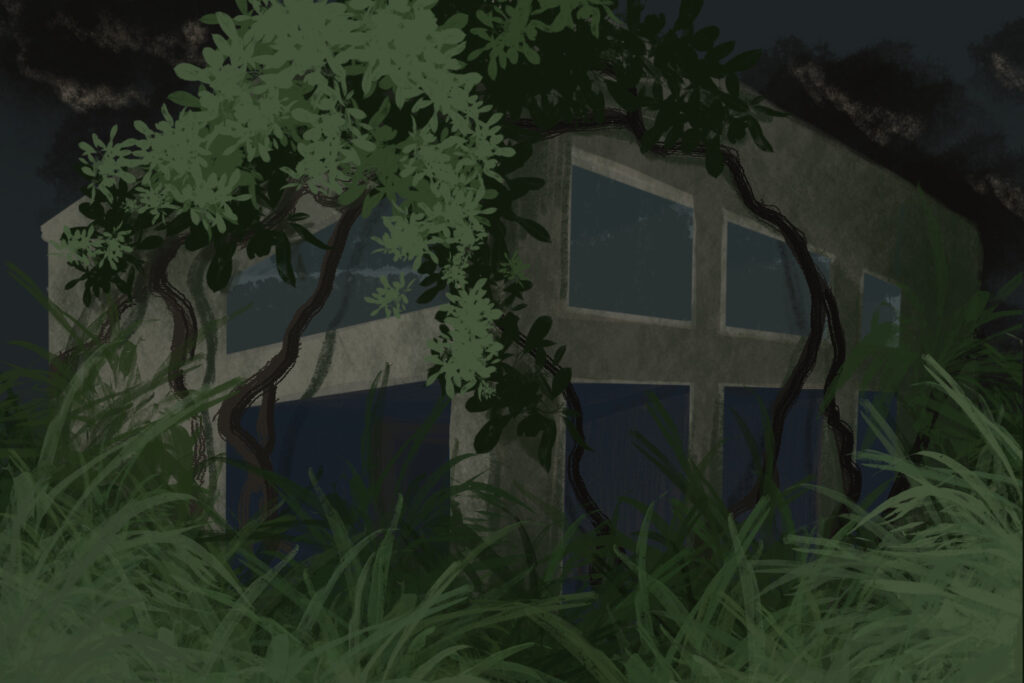This is not a place of honour
words by Kieran Guimond
illustration by Chelsey Wang
In the summer of 2019, my friend and I broke into an abandoned building.
Maybe saying we ‘broke in’ is a bit of an exaggeration; there was a piece of the fence that was busted. We crawled under it and from there you could walk into the building.
There was one section where you had to climb down a ‘ladder’—which was really just a grate that someone had placed at the top of the hole. Looking back, it probably wasn’t that dramatic—a short drop into a lower section—but at the time, I felt like I was discovering an entirely new world. We were brave-hearted adventurers traversing where no one had ever been before—if you could ignore the heaps of empty beer cans on the floor.
I can’t remember what my friend told me about what the place used to be. Maybe they never did.
I can barely recall what the inside of the building looked like; the photos I have from the trip are mainly of the Toronto skyline from the roof of the building. I remember that my friend had to dare me to make the (admittedly short) jump from one section of the roof to the other. I remember there was a wooden beam carved with the names of past explorers.
I’ve been thinking a lot about long-term nuclear warnings recently. The whole ‘this place is not a place of honour, no highly esteemed deed is commemorated here, nothing valued is here’ deal. I’ve been thinking about ghosts, about ghosts haunting a location, and about some locations having no ghosts and yet being haunted by something. I’m not a particularly spiritual person; I don’t think ghosts are real, but I do think there was something haunting that building when I visited it.
Every building we’ve ever visited is filled with the souls of those who came before. Not in a ‘they died and now their spirit walks the halls’ kinda way, but something more tangible. The crack in the wall where someone hit it in a fit of rage. The deep lines carved into the table where a knife slipped from a cook’s hand. All the signs are there, and they prove that there was life here once. Looking back, I wish I knew what that building used to be. I wonder if it was ever someone’s home, if someone took their first breath within those walls, lost their first tooth, and had their first kiss. I wonder how they would feel about it now: covered in graffiti, trash strewn across the floor.
The danger is unleashed only if you substantially disturb this place physically. This place is best shunned and left uninhabited.
Should these places be left alone and fade into nothingness? Is that really worse than what they currently are?
I wonder what the world will look like 100, 200, 1000 years from now. Will we be haunting the landscape, just like our ancestors do to us? Will they have built homes—monuments even—out of our bones? Or maybe all of human civilization will fall in a year, destroyed by a nuclear war that there were too many warning signs for. Maybe we’ll be discovered by another species, one that’s a little less self-destructive than ours. Maybe they’ll see our buildings and our statues and wonder at their beauty, and our spirits will still be alive.
We can look back on pottery that was made tens of thousands of years ago and see the fingerprints of the artists who made it and poured their souls into it. We can keep a spirit, the soul of the person alive through their creations, through the mark they left on the world. Maybe that won’t matter if there’s no world left to live in.
Will the building that I stood on three years ago—where I felt the warm summer breeze upon my face—still be there? Could it have been torn down for parts and scrap metal just a year after I saw it?
I wonder if my voice will be added to its whispering alcoves, echoing for the generations to hear.

